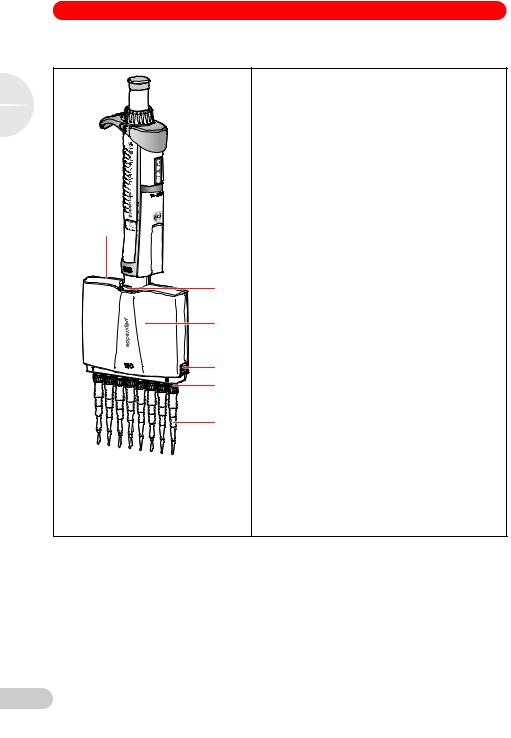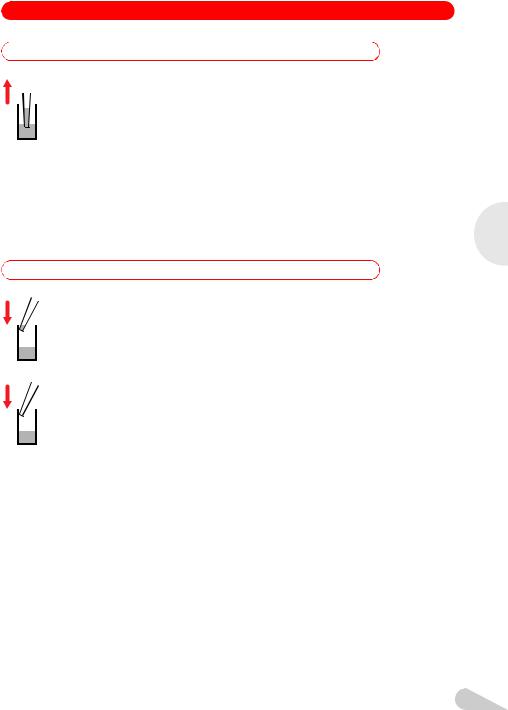Eppendorf Research plus User Manual

Eppendorf Research® plus
Operating manual

Copyright© 2010 Eppendorf AG, Hamburg. No part of this publication may be reproduced without the prior permission of the copyright owner.
Trademarks
Combitips®, eppendorf®, epT.I.P.S.®, Multipette®, Repeater® and Research® are registered trademarks of Eppendorf AG, Hamburg, Germany.
Registered trademarks are not marked in all cases with ™ or ® in this manual. U.S. Pat. No.
5,531,131
4,961,350
For user adjustment with adjustment display, spring to reduce force for tip fitting and for further features patents are pending.
Research plus - Operating Manual - en-02/0210

Eppendorf Research® plus — Operating manual
Table of contents
1 Product description . . . . . . . . . . . . . . . . . . . . . . . . . . . . . . . . . . . . . . . . . . . . . . . . . . . . . . 4
1.1 Features . . . . . . . . . . . . . . . . . . . . . . . . . . . . . . . . . . . . . . . . . . . . . . . . . . . . . . . . . . . . 4 1.2 Delivery package . . . . . . . . . . . . . . . . . . . . . . . . . . . . . . . . . . . . . . . . . . . . . . . . . . . . . 4 1.3 Main illustration . . . . . . . . . . . . . . . . . . . . . . . . . . . . . . . . . . . . . . . . . . . . . . . . . . . . . . 5 1.3.1 Research plus single-channel. . . . . . . . . . . . . . . . . . . . . . . . . . . . . . . . . . . . . . 5 1.3.2 Research plus multi-channel. . . . . . . . . . . . . . . . . . . . . . . . . . . . . . . . . . . . . . . 6 1.4 Materials. . . . . . . . . . . . . . . . . . . . . . . . . . . . . . . . . . . . . . . . . . . . . . . . . . . . . . . . . . . . 7
2 Safety . . . . . . . . . . . . . . . . . . . . . . . . . . . . . . . . . . . . . . . . . . . . . . . . . . . . . . . . . . . . . . . . . . 8
2.1 Intended use. . . . . . . . . . . . . . . . . . . . . . . . . . . . . . . . . . . . . . . . . . . . . . . . . . . . . . . . . 8 2.2 Warnings for intended use . . . . . . . . . . . . . . . . . . . . . . . . . . . . . . . . . . . . . . . . . . . . . . 8
3 Operation . . . . . . . . . . . . . . . . . . . . . . . . . . . . . . . . . . . . . . . . . . . . . . . . . . . . . . . . . . . . . . 10
3.1 Setting the volume (only Research plus variable) . . . . . . . . . . . . . . . . . . . . . . . . . . . 10 3.2 Using pipette tips . . . . . . . . . . . . . . . . . . . . . . . . . . . . . . . . . . . . . . . . . . . . . . . . . . . . 10 3.3 Aspirating liquid . . . . . . . . . . . . . . . . . . . . . . . . . . . . . . . . . . . . . . . . . . . . . . . . . . . . . 11 3.4 Dispensing liquid . . . . . . . . . . . . . . . . . . . . . . . . . . . . . . . . . . . . . . . . . . . . . . . . . . . . 11
4 Troubleshooting . . . . . . . . . . . . . . . . . . . . . . . . . . . . . . . . . . . . . . . . . . . . . . . . . . . . . . . . 12
4.1 Error search . . . . . . . . . . . . . . . . . . . . . . . . . . . . . . . . . . . . . . . . . . . . . . . . . . . . . . . . 12
5 Maintenance . . . . . . . . . . . . . . . . . . . . . . . . . . . . . . . . . . . . . . . . . . . . . . . . . . . . . . . . . . . 14
5.1 Cleaning . . . . . . . . . . . . . . . . . . . . . . . . . . . . . . . . . . . . . . . . . . . . . . . . . . . . . . . . . . . 14 5.2 Sterilizing or disinfecting the pipette . . . . . . . . . . . . . . . . . . . . . . . . . . . . . . . . . . . . . . 15 5.2.1 Autoclaving . . . . . . . . . . . . . . . . . . . . . . . . . . . . . . . . . . . . . . . . . . . . . . . . . . . 15 5.2.2 Disinfection . . . . . . . . . . . . . . . . . . . . . . . . . . . . . . . . . . . . . . . . . . . . . . . . . . . 16 5.3 Replacing O-rings. . . . . . . . . . . . . . . . . . . . . . . . . . . . . . . . . . . . . . . . . . . . . . . . . . . . 16 5.3.1 Removing the O-ring. . . . . . . . . . . . . . . . . . . . . . . . . . . . . . . . . . . . . . . . . . . . 16 5.3.2 Mounting a new O-ring . . . . . . . . . . . . . . . . . . . . . . . . . . . . . . . . . . . . . . . . . . 16
5.4 Research plus disassembly and assembly . . . . . . . . . . . . . . . . . . . . . . . . . . . . . . . . 17 5.4.1 Single-channel up to 1 000 μL . . . . . . . . . . . . . . . . . . . . . . . . . . . . . . . . . . . . 17 5.4.2 5 mL and 10 mL single-channel . . . . . . . . . . . . . . . . . . . . . . . . . . . . . . . . . . . 19 5.4.3 Multi-channel . . . . . . . . . . . . . . . . . . . . . . . . . . . . . . . . . . . . . . . . . . . . . . . . . 20 5.5 Adjusting pipettes . . . . . . . . . . . . . . . . . . . . . . . . . . . . . . . . . . . . . . . . . . . . . . . . . . . . 22 5.5.1 General notes on user and factory adjustment settings . . . . . . . . . . . . . . . . . 22 5.5.2 Changing the user adjustment . . . . . . . . . . . . . . . . . . . . . . . . . . . . . . . . . . . . 24 5.5.3 Changing the factory adjustment . . . . . . . . . . . . . . . . . . . . . . . . . . . . . . . . . . 25 5.5.4 Research plus variable - changing the factory adjustment . . . . . . . . . . . . . . . 25 5.5.5 Error limits in accordance with ISO 8655-2. . . . . . . . . . . . . . . . . . . . . . . . . . . 31
5.6 Decontamination before shipment . . . . . . . . . . . . . . . . . . . . . . . . . . . . . . . . . . . . . . . 34
6 Technical data . . . . . . . . . . . . . . . . . . . . . . . . . . . . . . . . . . . . . . . . . . . . . . . . . . . . . . . . . . 35
6.1 Research plus single-channel variable. . . . . . . . . . . . . . . . . . . . . . . . . . . . . . . . . . . . 35 6.2 Research plus multi-channel variable. . . . . . . . . . . . . . . . . . . . . . . . . . . . . . . . . . . . . 37 6.3 Research plus fix . . . . . . . . . . . . . . . . . . . . . . . . . . . . . . . . . . . . . . . . . . . . . . . . . . . . 38 6.4 Ambient conditions . . . . . . . . . . . . . . . . . . . . . . . . . . . . . . . . . . . . . . . . . . . . . . . . . . . 39
7 Ordering information . . . . . . . . . . . . . . . . . . . . . . . . . . . . . . . . . . . . . . . . . . . . . . . . . . . . 40
contents of Table
3

Eppendorf Research® plus — Operating manual
1 Product description
1.1Features
The Research plus pipettes are piston-stroke pipettes that operate according to the air-cushion principle.
1When the control button is pressed, the piston in the pipette moves in the same direction. If the control button and the piston are moved upwards, the liquid can be aspirated into the pipette tip. With the downward movement of the piston, the liquid is dispensed (measuring stroke).
Product description
Blow-out occurs if the downward piston stroke exceeds the first stop.
Depending on the Research plus pipette it is possible to dispense volumes from 0.1 μL to 10 mL.
The Research plus family consists of single-channel and multi-channel pipettes (8 and 12-channels) with variable volume settings, as well as single-channel fixed-volume pipettes. You can find a list of all available models of the Research plus in the "Technical Data" section.
All Research plus pipettes are fully autoclavable.
You can adjust the Research plus pipettes. The side viewing window displays the change in the adjustment.
When attaching a pipette tip, the spring-loading action of the tip cone is activated (exceptions 5 mL and 10 mL pipettes).
1.2Delivery package
The Research plus delivery package contains:
Pcs. |
Description |
|
|
1 |
Research plus operating manual |
|
|
1 |
Certificate |
|
|
1 |
Adjustment tool (Allen key with a blue handle) |
|
|
1 |
Mini CD |
|
|
1 |
Black locking ring for single-channel pipettes ≤ 1,000 μL |
|
|
5 |
Red adjustment seal |
|
|
5 |
Protective filters for 5 mL and 10 mL pipettes |
|
|
1 |
Pipette key for opening the lower part (5 mL and 10 mL) |
|
|
1 |
O-ring tool for cutting the O-rings (only multi-channel 100 μL and 300 μL) |
|
|
1 |
Safety plug tool |
|
|
1 |
Pin for loosening the safety plug |
|
|
4

Eppendorf Research® plus — Operating manual
1 Product description
1.3Main illustration
1.3.1Research plus single-channel
|
|
|
|
|
|
|
|
|
|
|
|
|
|
|
1 Control button |
|
|
|
|
|
|
|
|
|
|
|
|
|
|
1 |
The control button and the trays of the matching epT.I.P.S. pipette |
|
|
|
|
|
|
|
|
|
tips have the same color. |
||||||
|
|
|
|
|
|
|
|
|
|
|
|
|
|
2 |
|
|
|
|
|
|
|
|
|
|
|
|
|
|
2 Volume adjustment ring |
||
|
|
|
|
|
|
|
|
|
|
|
|
|
|
||
|
|
|
|
|
|
|
|
|
|
|
|
|
|
3 |
|
|
|
|
|
|
|
|
|
|
|
|
|
|
|
To set the volume for the variable pipettes. |
|
|
|
|
|
|
|
|
|
|
|
|
|
|
|
||
|
|
|
|
|
|
|
|
|
|
|
|
|
4 |
3 Ejector |
|
|
|
|
|
|
|
|
|
|
|
|
|
|
|||
|
|
|
|
|
|
|
|
|
|
|
|
|
|||
|
|
|
|
|
|
|
|
|
|
|
|
The ejector moves the ejector sleeve and ejects the pipette tip. |
|||
|
|
|
|
|
|
|
|
|
|
|
|
|
|
|
|
|
|
|
|
|
|
|
|
|
|
|
|
|
5 |
4 Volume display (only variable pipettes) |
|
|
|
|
|
|
|
|
|
|
|
|
|
|
|||
|
|
|
|
|
|
|
|
|
|
|
|
The set volume is read from top to bottom. |
|||
|
|
|
|
||||||||||||
|
|
|
|
|
|
|
|
|
|
|
|||||
|
|
|
|
|
|
|
|
|
|
|
6 |
5 Adjustment opening |
|||
|
|
|
|
|
|
|
|
|
|
|
|||||
|
|
|
|
|
|
|
|
|
|
|
|
|
|
7 |
|
|
|
|
|
|
|
|
The adjustment opening is fitted with the gray adjustment seal |
||||||||
|
|
|
|
|
|
|
|
|
|
|
|
|
|
|
|
|
|
|
|
|
|
|
|
|
|
|
|
|
|
|
before delivery. |
|
|
|
|
|
|
|
|
8 |
6 Adjustment display |
||||||
|
|
|
|
|
|
||||||||||
|
|
|
|
|
|
|
|
|
|
|
|
|
|
|
|
|
|
|
|
|
|
|
|
|
|
|
|
|
|
|
Set to "0" before delivery. |
|
|
|
|
|
|
|
|
|
|
|
|
|
|
|
7 Labeling field |
|
|
|
|
|
|
|
|
|
|
|
|
|
|
|
Space for labels containing internal lab information. The serial |
|
|
|
|
|
|
|
|
|
|
|
|
|
|
|
number appears at the bottom. |
|
|
|
|
|
|
|
|
|
|
|
|
|
|
9 |
8 Ejector sleeve |
|
|
|
|
|
Eject the pipette tips after use. |
||||||||||
|
|
|
|||||||||||||
|
|
10 |
9 Spring-loaded tip cone |
||||||||||||
|
|||||||||||||||
|
|
|
|
|
|
|
|
|
|
|
|
|
|
|
|
|
|
|
|
|
|
|
|
|
|
|
|
|
|
|
The spring loading action optimizes the force required for |
|
|
|
|
|
|
|
|
|
|
|
|
|
|
|
attaching and ejecting tips (no spring-loaded action with 5 mL |
|
|
|
|
|
|
|
|
|
|
|
|
|
|
|
and 10 mL pipettes). The 5 mL and 10 mL pipettes have an |
|
|
|
|
|
|
|
|
|
|
|
|
|
|
|
easily replaceable protection filter in the tip cone. |
|
|
|
|
|
|
|
|
|
|
|
|
|
|
|
10 Pipette tip |
|
|
|
|
|
|
|
|
|
|
|
|
|
|
|
The Research plus pipettes can only be used in combination with |
|
|
|
|
|
|
|
|
|
|
|
|
|
|
|
matching pipette tips. It is recommended to use epT.I.P.S. |
|
|
|
|
|
|
|
|
|
|
|
|
|
|
|
|
1
description Product
5

1
Product description
Eppendorf Research® plus — Operating manual
1 Product description
1.3.2Research plus multi-channel
6
1
2
3
4
5
For an explanation of the upper part of the pipette, refer to the main illustration of the single-channel pipette (see p. 5).
1 Lever
To loosen the multi-channel lower part.
2 Multi-channel lower part
The multi-channel lower part is freely rotatable. The lower part does not detach when it is rotated. The outer channels are labeled with the numbers 1 and 8 (or 12).
The multi-channel version has a piston for each channel so that fewer than 8 or 12 tips can also be fitted.
The lower part can be converted from an 8 to a 12-channel version with the same volume range. The multi-channel lower part can be opened, enabling you to replace or remove individual channels.
3 Latches on the right and left
To release the cover plate with the interior ejector rail.
4 Spring-loaded tip cones
The spring loading action optimizes the force required for attaching and ejecting tips.
5 Pipette tips
It is recommended to use epT.I.P.S.
6 Cover plate
Detachable cover plate with an interior ejector rail. The cover plate is opposite the side with the
lever (1). In the view shown here, the cover plate is the rear side of the lower part.
6

Eppendorf Research® plus — Operating manual
1 Product description
1.4Materials
CAUTION! Aggressive substances can damage the device, dispensing unit and accessories.
Check for material compatibility before using organic solvents and aggressive chemicals.
Follow the cleaning instructions (see Cleaning on p. 14).
The user-accessible components of the Research plus are made of the following materials:
Component |
Material |
|
|
External surfaces of the upper part |
Purified polypropylene (PP), |
|
polycarbonate (PC), |
|
polyetherimide (PEI), |
|
foil |
|
|
Exterior and interior of lower parts |
Purified polypropylenen (PP), |
|
polyvinylidene fluoride (PVDF), |
|
polyetherimide (PEI), |
|
polyphenylene sulfide (PPS), |
|
polyetheretherketone (PEEK), |
|
polytetrafluorethylene (PTFE), |
|
ethylene-propylene-diene rubber (EPDM), |
|
silicone, |
|
steel (stainless steel and spring steel) |
|
|
|
|
Pipette tip |
Material |
|
|
epT.I.P.S. |
Polypropylene (PP) |
|
|
epDualfilter T.I.P.S. filter |
Polyethylene (PE) |
|
|
1
description Product
7

2
Safety
Eppendorf Research® plus — Operating manual
2 Safety
2.1Intended use
The Research plus is a lab device intended for dispensing liquids in the volume range from
0.1 μL to 10 mL, in combination with matching pipette tips. In vivo applications (applications in or on the human body) are not permitted.
The Research plus may only be operated by trained specialist staff. All users must have read the operating manual carefully and familiarized themselves with the device's mode of operation.
2.2Warnings for intended use
WARNING! Damage to health due to handling infectious liquids and pathogenic germs.
Observe the national regulations for handling these substances, the biological security level of your laboratory, the material safety data sheets and the manufacturer's application notes.
Wear personal protective equipment (PPE).
Follow the instructions regarding hygiene, cleaning and decontamination.
For complete instructions regarding the handling of germs or biological material of risk group II or higher, please refer to the "Laboratory Biosafety Manual" (source: World Health Organization, current edition of the Laboratory Biosafety Manual).
WARNING! Damage to health due to toxic, radioactive or aggressive chemicals.
Observe the national regulations for handling these substances as well as the material safety data sheets and manufacturer's application notes.
Wear personal protective equipment (PPE).
CAUTION! Danger to persons from careless use.
Never point the opening of a Research plus fitted with pipette tip at yourself or anyone else.
Only initiate dispensing if it is safe to do so.
For all dispensing tasks, make sure that you are not endangering yourself or anyone else.
CAUTION! Poor safety due to incorrect accessories and spare parts.
The use of accessories and spare parts other than those recommended by Eppendorf may impair the safety, functioning and precision of the device. Eppendorf cannot be held liable or accept any liability for damage resulting from the use of incorrect or non-recommended accessories and spare parts or from the improper use of such equipment.
Only use accessories and original spare parts recommended by Eppendorf.
NOTICE! Damage to device from missing pipette tips.
Only use the Research plus with fitted pipette tips.
When using standard tips (without a filter): use the 1 - 10 mL and 0.5 - 5 mL pipettes only with the protection filter inserted.
8

Eppendorf Research® plus — Operating manual
2 Safety
NOTICE! Carry-over, contamination and incorrect dispensing results due to the incorrect use of pipette tips.
The pipette tips are for single use only. Prolonged use can have a negative impact on dispensing tasks.
Use the pipette tips only once.
Do not autoclave the epT.I.P.S. Dualfilter.
NOTICE! Incorrect dispensing volume for special liquids and from temperature differences.
Solutions which differ greatly from water in terms of their physical data, or temperature differences between the pipette, pipette tip and liquid can result in incorrect dispensing volumes.
Avoid temperature differences between pipette, pipette tip and liquid.
Make sure that the temperature is constant, between 20 and 25°C and at ±0.5°C. Check the dispensing volume and readjust the pipette in case of deviations.
2
Safety
9

3
Operation
Eppendorf Research® plus — Operating manual
3 Operation
3.1Setting the volume (only Research plus variable)
Turn the volume setting ring as depicted to adjust the volume.
The height of the control button changes as the volume is adjusted.
The numbers on the volume display are to be read from the top to the bottom. The decimal places are below the hyphen.
The volume is displayed up to 1 000 μL in μL. For the 5 mL and 10 mL sizes, the volume is displayed in mL.
We recommend to adjust the volume setting from a higher value to a lower value. If required, turn beyond the required value and then back again.
3.2Using pipette tips
The liquid to be dosed is aspirated into pipette tips. It is recommended to use epT.I.P.S. The epT.I.P.S. pipette tips are available in different purities, as tips with and without a filter and as special tips. When using liquids whose surface tension is lower than that of water (e.g., due to the presence of a wetting agent in the liquid), the use of the special tips epT.I.P.S. LoRetention is recommended.
The pipette is only functional if a pipette tip has been
attached. You can either attach the pipette tip by hand or directly insert the end of the pipette into a tip held in the tip storage box. If attaching a pipette tip by hand, it must be handled in such a way to avoid contamination and heating of
the pipette tip.
The color of the control button of the Research plus matches the color of the epT.I.P.S. tray.
If you are using pipette tips without a filter, insert the
protection filter into the 5 mL and 10 mL pipettes.
If you are using the 5 mL or 10 mL epDualfilter T.I.P.S.,
remove the protection filter in the pipette. This also
applies to 5 mL / 10 mL filter tips of other manufacturers.
The filters can interfere with each other. The
backpressure of the two filters makes it difficult to exactly identify the first stop (see p. 11).
Fit the suitable pipette tip(s) on the tip cone, applying light pressure.
The pipette tip is securely attached to the tip cone when it responds with spring-loaded action (exceptions: no spring-loading action for 5 mL and 10 mL single-channel pipettes)
You can deactivate the spring loading action of the tip cone in the case of single-channel pipettes (see p. 17).
10

Eppendorf Research® plus — Operating manual
3 Operation
3.3Aspirating liquid
1.The liquid to be aspirated must be taken from a suitable vessel. For multi-channel pipettes, we recommend the reagent reservoir "Tip-Tub".
2.Press down the control button to the first stop (measuring stroke).
3.Immerse the pipette tip(s) vertically approx. 4 mm into the liquid.
4.To aspirate liquid, allow the control button to slide back slowly. Maintain the immersion depth, so that no air is aspirated accidentally.
5.In the case of large volumes: before removing the pipette tip from the liquid, wait for approx. 3 seconds. To ensure maximum precision and accuracy, we recommend to wet each new tip initially by aspirating and dispensing the liquid one to three times. Only then should pipetting commence.
6.Remove the tip(s) slowly from the liquid.
7.Wipe the tip(s) slowly against the tube wall to ensure that no outer wetting remains on the tip.
3.4Dispensing liquid
1.Place the tip(s) on the tube wall at an angle.
2.Press the control button slowly until the first stop (measuring stroke) and
wait until the flow of liquid stops.
3.To empty the tip(s) completely, press down the control button until the second stop (blow-out).
4.Hold down the control button and wipe the tip(s) against the tube inner wall.
5.Let the control button slide back slowly outside of the tube.
6.To eject the tips, press the ejector.
Pipette tips are for single use only.
3
Operation
11

4
Troubleshooting
Eppendorf Research® plus — Operating manual
4 Troubleshooting
4.1 Error search
Symptom |
Possible cause |
Solution |
||
|
|
|
|
|
Liquid is dripping from |
• |
The tip is loose or the |
Press the tip on firmly, use |
|
the tip and/or the |
|
pipette tip is poorly fitted. |
epT.I.P.S. If using 5 mL and |
|
dispensed volume is |
|
|
10 mL epDualfilter T.I.P.S., do |
|
incorrect. |
|
|
not use protection filters in the |
|
|
|
|
pipette. |
|
|
|
|
||
|
• Liquid with high vapor |
Wet the tip several times and |
||
|
|
pressure and/or different |
adjust the pipette for the liquid |
|
|
|
density. |
used. |
|
|
|
|
|
|
|
• |
Pipetted too quickly. |
Move the control button slowly. |
|
|
|
|
||
|
• The tip is withdrawn from |
Slowly remove the tip with a |
||
|
|
the liquid too quickly. |
time delay (approx. 3 seconds) |
|
|
|
|
from the liquid. |
|
|
|
|
|
|
|
• |
Liquid aspirated with |
Repeat dispensing correctly. |
|
|
|
blow-out and dispensed |
|
|
|
|
with blow-out. |
|
|
|
|
|
||
|
• The piston is soiled or |
Clean the piston, relubricate |
||
|
|
damaged. |
slightly and/or replace. |
|
|
|
|
|
|
|
• |
The tip cone is damaged. |
Replace the lower part or |
|
|
|
|
channel. |
|
|
|
|
||
|
• The O-rings of the tip |
Replace the O-rings (only |
||
|
|
cones are damaged. |
100 μL, 300 μL multi-channel). |
|
|
|
|
|
|
The control button jams |
• |
The piston is soiled. |
Clean the lower part. |
|
and does not move |
• |
The seal is soiled. |
5 mL and 10 mL sizes: replace |
|
smoothly. |
• |
The pipette is blocked. |
the protection filter. |
|
|
|
|
|
|
The adjustment seal has |
• |
The pipette has been |
Adjust the pipette for the liquid |
|
been removed; the |
|
adjusted for another |
used (see Adjusting pipettes on |
|
adjustment display has |
|
liquid. |
p. 22). |
|
been changed. |
|
|
|
|
|
|
|
|
|
No spring-loading action |
• |
Spring-loading action is |
Remove the locking ring again. |
|
of the tip cone when |
|
blocked by a locking ring. |
|
|
taking up pipette tips. |
|
|
|
|
• The use of a 5 mL or |
No remedy. The tip cone does not |
|||
|
||||
|
|
10 mL pipette. |
respond with spring-loaded action in |
|
|
|
|
combination with these sizes. |
|
|
|
|
|
|
12

Eppendorf Research® plus — Operating manual
4 Troubleshooting
To avoid dispensing errors, check the precision and accuracy of the Research plus at regular intervals. The "PICASO" program (from Version 2.3) is available to determine the permitted measured systematic and random errors. If the pipette is used at an extremely high location, it must be adjusted to the ambient air pressure. A SOP (Standard Operation Procedure) for checking pipettes can be found on the Research plus CD and on our website www.eppendorf.com.
4
Troubleshooting
13
